We’re going to start this article by investigating where heat pumps are good value for money. Suppose you had over £10,000 to spend on an energy-related installation for your house. How might you apportion the funds across the following three categories?
- Reducing heat-loss / improving insulation
- Installing electricity micro-generation such as PV solar panels and possibly a home storage battery too
- Installing a heat pump, either ground source (GSHP) or air source (ASHP)
There isn’t one single ‘correct’ answer, and the expenditure will be apportioned differently according to the current state of the property.
Over the past 25 years the public has tended to put most of their money into solar panels (option 2 above), with the rest being used in additional loft or wall insulation (option 1). But this choice has been biased due to the Feed-In Tariff (FiT) which paid money to households generating electricity, even if most of that was consumed by the home itself instead of being exported to the grid.
The FiT has now gone. The replacement Smart Export Guarantee only pays for power actually sent back to the distribution grid, and at a much lower level. OVO pays 4p/kWh at the time of writing, regardless of what time of day the electricity is offered. Microgeneration is now less financially viable.
Two guidelines dominate the decision-making process:
a: Additional insulation is more viable than both micro-generation and heat pumps in terms of both energy efficiency and cost
b: A heat pump requires a house with an Energy Efficiency Rating of A or B
In the UK, Energy Efficiency is calculated using the Standard Assessment Procedure to create a SAP-score between 1 to 100.
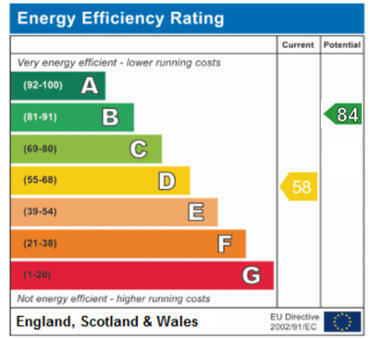
The two types of heat pump
If your house can’t achieve a SAP score above 80, then there’s no point considering a heat pump. It costs about £160 for a qualified surveyor to calculate your SAP and the average SAP score for a house in the UK is 54.
If your house has a sufficiently high energy rating, and you’re considering a heat pump, first note that there are two main types.
The ground source heat pump (GSHP) uses a substantial length of pipework as a ‘collector’ to absorb heat from the surrounding soil. This requires excavation to at least 1.5m depth, and preferably 2-3m.
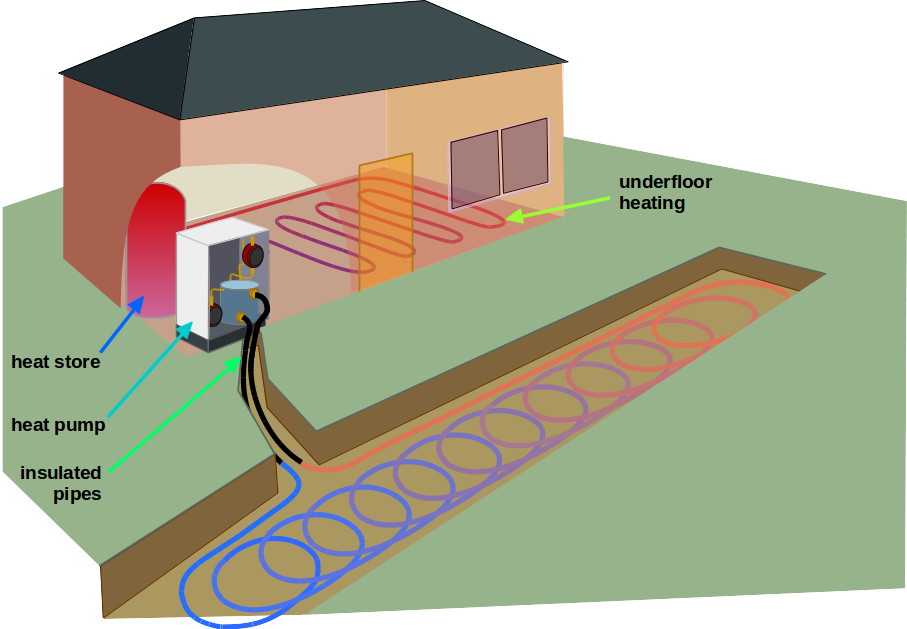
There are two sub-categories of GSHP in which the collector may be:
- In water – typically river or pond
- In a borehole – drilled into the bedrock to a depth around 80-100m
In either case, you may need an extraction license from your local water company, even if the water itself isn’t being removed.
The other main type is an air source heat pump (ASHP) in which the collector is reduced to a large finned radiator. A fan is used to suck air through the collector, thereby extracting heat from the surrounding air.
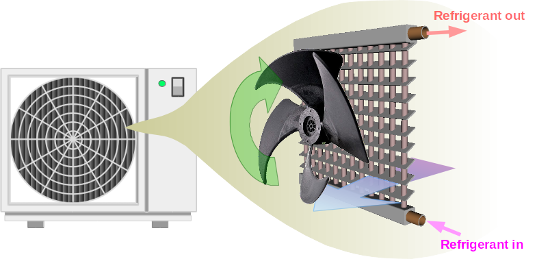
How does a heat pump work?
The principle is very similar to a fridge in that a heat-pump uses a compressor and a fluid which passes easily between its liquid and gaseous forms. This is based on Charles’ Law †
When its pressure remains constant, the volume occupied by a gas is directly proportional to its absolute temperature.
Thus, as a gas is compressed (reducing the volume), its temperature will rise.
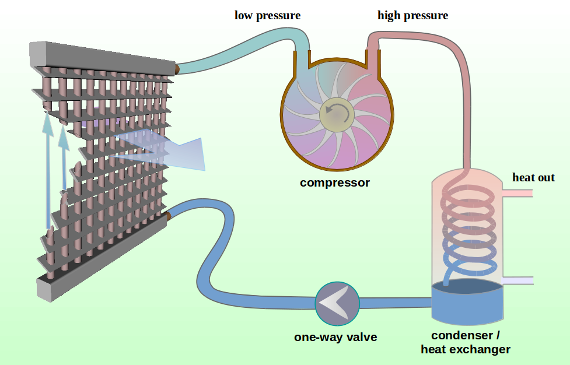
The refrigerant enters the collector (the radiator grill) as a fluid and picks up heat from the air-stream. As this passes through the compressor, the increased pressure causes the temperature to rise further. Within the heat exchanger unit, that energy passes into the surrounding water, causing the refrigerant to condense, and the cycle repeats.
It takes electrical energy to operate the compressor, but an optimised GSHP system might achieve a coefficient of performance (COP) of 4. That means it delivers 4kW of heat output for every 1kW consumed.

As with other forms of renewable, zero carbon energy, a heat pump operates slowly over a long period of time. It is most efficient when the heat is stored for use later, and when lower temperatures can be utilised:
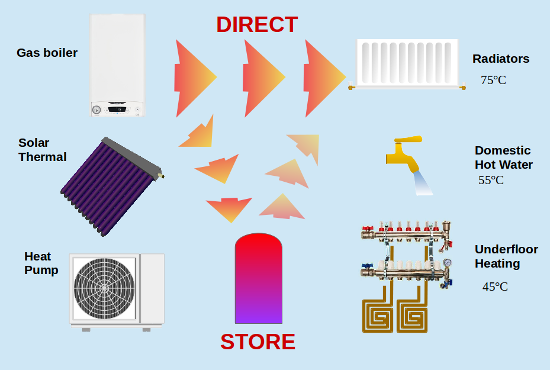
As the UK moves towards ‘time of use’ tariffs, it will become more expensive to use electricity during the early evening peak period from 17:00 onwards. Sufficient energy needs to be stored to avoid importing electricity by then.
There are two main approaches to ensure that a heat pump site can operate for several hours during peak demand without drawing power from the national grid:
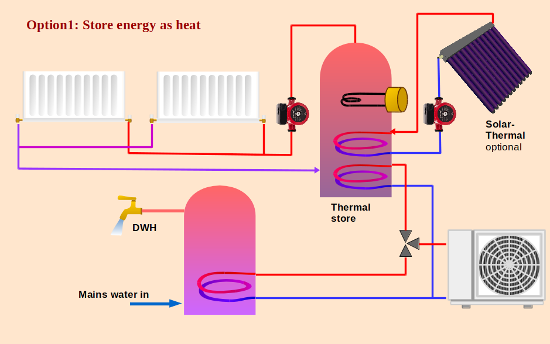
Although the diagrams show the thermal store delivering space heating via radiators, it would achieve greater efficiency if underfloor heating was installed due to the lower temperature required.
The greater the output temperature which the heat pump must attain, the lower is its efficiency (COP).
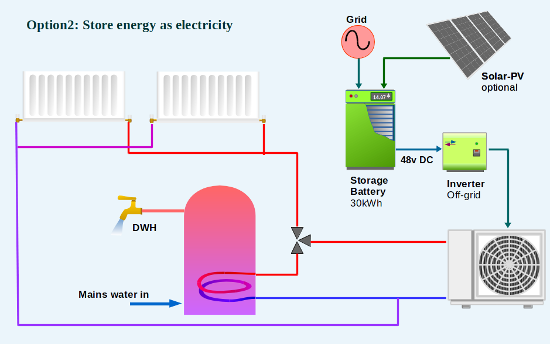
The battery storage option is easier to install and occupies significantly less space, but note that the capacity required is similar to that of a small electric car!
Costs can be reduced by retaining partial gas heating together with a hybrid ASHP. This approach was successfully trialed in the two-year Freedom Project, which concluded in Spring 2017.
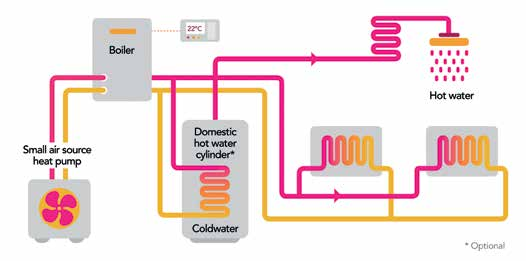
 Western Power Distribution and used with permission
Western Power Distribution and used with permissionFreedom was a partnership project between Western Power Distribution, Wales and West Utilities, and funded by the Welsh Government.
What permissions are required?
1: The regional Distribution Network Operator (DNO) must be notified of all grid connections of devices requiring 16A or more.
Most DNOs use the standard ENA Application Form. The Electricity Networks Association represents all UK DNOs and provides stability and harmonisation of practices.
Here’s the link to the ENA Forms for applicants installing Heat Pumps in SE England. There are two levels of application depending on whether the installation fulfills the criteria for the fast-track Smart Connect process. This only works for heat pumps that are already approved and listed on the ENA’s databases.
Sites which require connections for two such devices may be refused or requested to pay for local grid enhancement. The most common devices in question would be a house with an existing EV charger point which now wants a heat pump or air conditioning system.
See Obtaining permissions from your DNO for more comprehensive explanation.
2: Building Regulations. Installation of Heat pumps falls within at least two categories of the Building Act:
Part-L1B, Conservation of fuel and power in existing buildings
Part-P, Electrical Safety
Many installers will be registered under the Competent Persons scheme, meaning that they may undertake the work due to their qualifications and membership of the appropriate trade body. However, they are still required to notify the Local Authority with oversight of Building Regulations, who can insist on their own inspection.
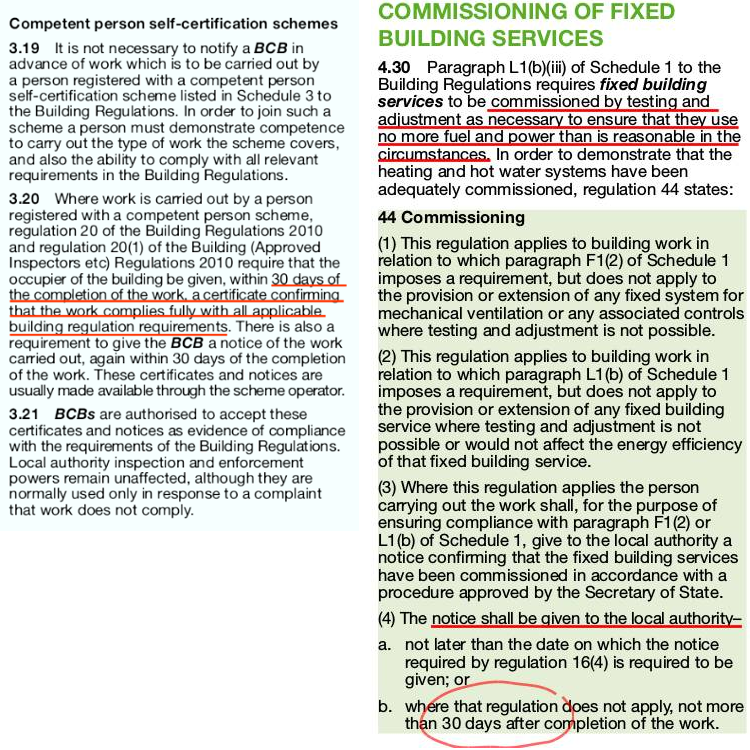
This article was first published on the OVO Energy forums.

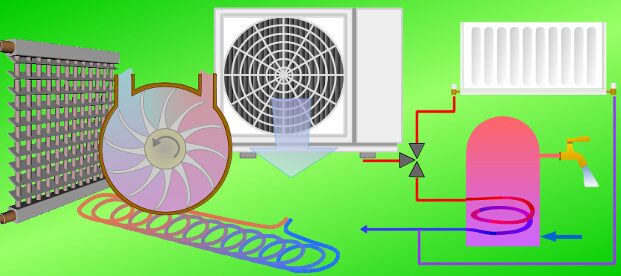

‘If your house can’t achieve a SAP score above 80, then there’s no point considering a heat pump.’ On what basis? Monetary – maybe? Carbon with a 100% renewable tariff – I think not?
Don’t get me wrong: I’m not dissing the benefits of insulation or air management, but that statement doesn’t stand on it’s own and isn’t supported by the rest of the article. Smacks of ‘eating eggs are bad for you…’ syndrome.
Guess I need to look at the OVO Energy forum.
Mike, That’s a quote from one of the senior engineers who designed and ran the Freedom HP Project commissioned by the Welsh Government. I didn’t record the conversation so I can’t continue the explanation. However the context was the need to address the insulation and fabric of the existing building first rather than simply install the heat pump itself.
There are currently three BEIS-funded trials under way in England, each of which has 250 sites where heat pumps are installed. Each house had an energy assessment first, but there was a fixed amount of £s allocated to increase the EPC per site. That means there is no common baseline against which to measure the viability of each installation.
In some cases, the home owner decided to invest additional funds into energy efficiency measures. Since that was not recorded and no reassessment was carried out prior to the HP being fitted, it is now not possible to tell whether the BEIS trials provide satisfactory solutions or not.
What we can say from the BEIS Trial run by OVO in SE England, is that the deficiencies in the HP installation by ‘professional’ companies are at least as significant as the deficiencies in the building’s SAP-score! The participants have recorded hundreds of badly-designed systems and improperly installed components.
That doesn’t bode well for any future initiative by HMG to extend the use of HPs throughout the UK.
Thanks: I can now understand how such a sweeping statement came to be made.
My extremely limited personal experience of ASHP installations mirrors the OVO trial, with 2 of the 3 experiencing a variety of issues.
I also have to agree with your final sentence: would the building trade manage better with improving insulation / air tightness?!?